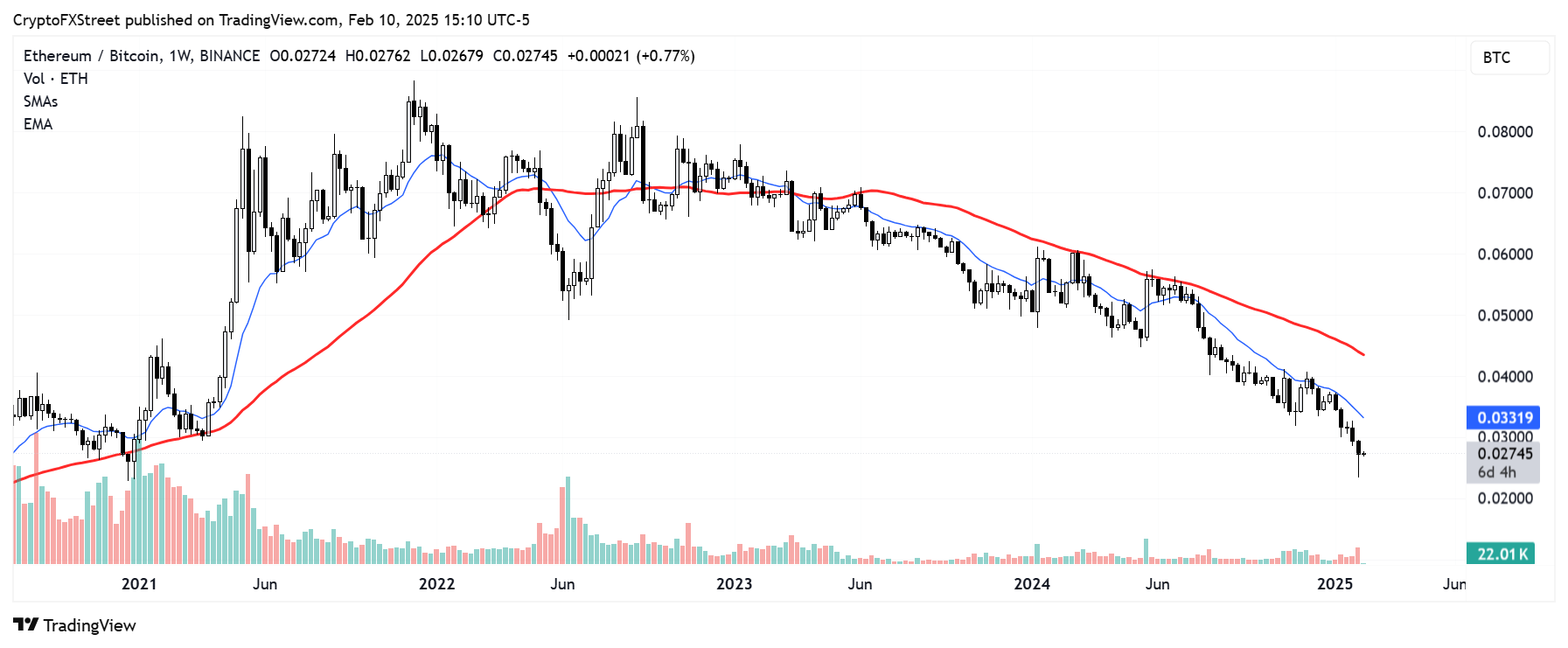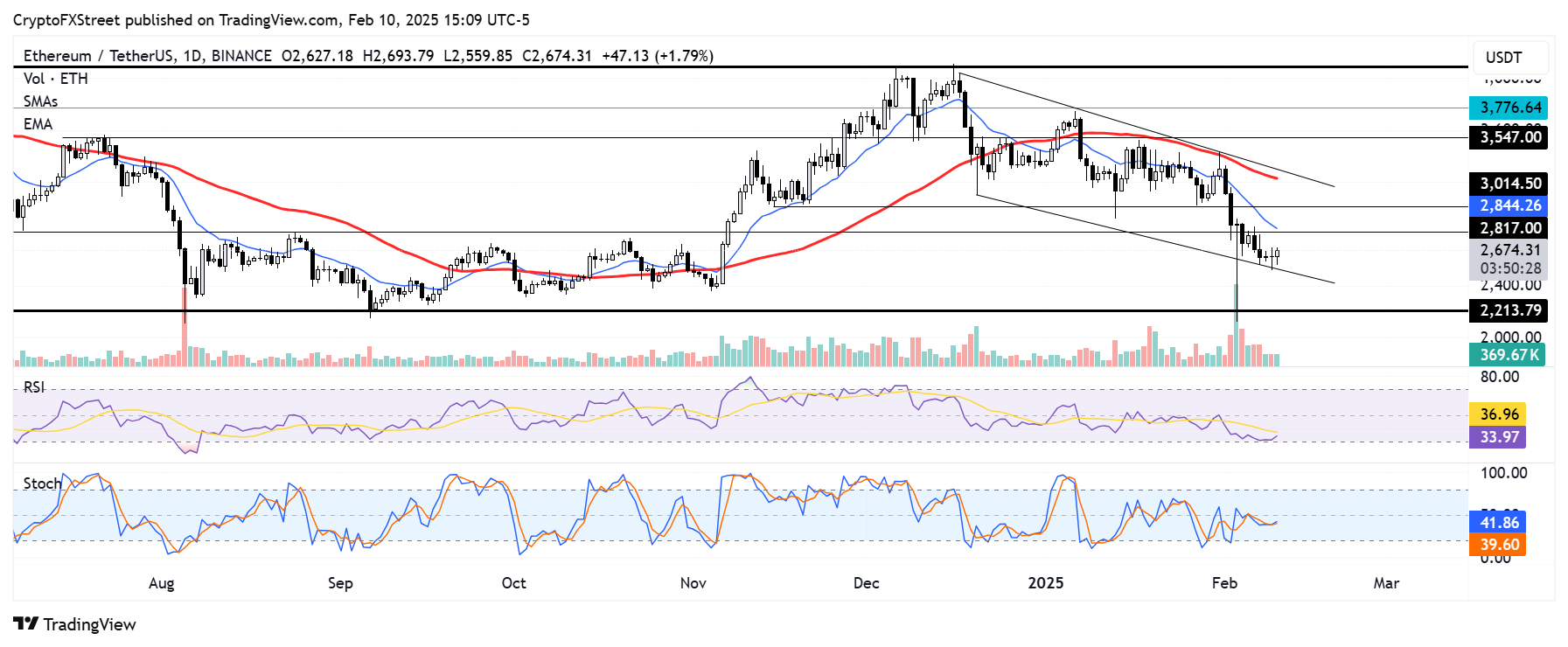Ethereum Price Forecast: ETH could see increased volatility as CME shorts soar to record highs
Ethereum price today: $2,670
- Ethereum's short positions on the CME soared 40% to a new all-time high following rising negative sentiments.
- Increased ETH ETF inflows alongside rising short positions indicate investors may be leveraging Ethena's cash-and-carry strategy.
- Ethereum could rally to a descending channel's upper boundary but faces a key hurdle near $2,817.
Ethereum (ETH) gained 2% on Monday despite investors' increased Chicago Mercantile Exchange (CME) short positions on the top altcoin. The high shorts have led to speculation of a potential short squeeze, fuelling market volatility.
Ethereum shorts pile up, ETH ETFs attempt to bridge the gap
Ethereum's short positions on the CME, the main avenue for trading ETH futures in the United States (US), surged by over 40% to a record high in the past week, according to data from Barchart.
Short positions started ramping up in November following the crypto market rally, reaching a 500% increase in three months before the US-induced global trade war tensions sparked a 37% plunge in ETH's price.
BREAKING : Ethereum
— Barchart (@Barchart) February 9, 2025
Speculators have built the largest $ETH short position in history pic.twitter.com/GVpKfi0Aw7
The increased short positions partly stem from ETH's underperformance of Bitcoin (BTC) in the current crypto market cycle.
While BTC has reached new all-time highs several times over the past year, ETH is 45% below its all-time high of $4,868, last seen in November 2021. As a result, BTC's market cap has grown six times larger than ETH's, with its dominance reaching record highs, per The Kobeissi Letter.

ETH/BTC weekly chart
Despite the rising shorts, US spot Ethereum ETF investors — spearheaded by BlackRock — have maintained a bullish view, buying up more than $3 billion worth of ETH over the past three months — in which CME shorts increased rapidly, per Coinglass data.
Over the past week, where the CME ETH shorts surged by 40%, Ethereum ETFs recorded a seventh consecutive day of net inflows, totaling $515.8 million.
The rising correlation between ETH ETF inflows and CME shorts indicates more investors may be employing DeFi protocol Ethena's cash-and-carry delta-neutral strategy of their synthetic stablecoin.
On the other hand, markets often post an opposite reaction when sentiments are low, and shorts are increasingly elevated. Hence, some crypto community members anticipate a potential ETH short squeeze in the coming weeks.
Meanwhile, in a note to FXStreet, Derive founder Nick Forster shared:
"The options markets are pricing in a 15% chance of ETH reaching over $5.5K by the end of the year, up from 14% last week, and a 20% chance it falls below $1,700, which is down from 22% last week."
"We expect ETH's monthly implied volatility (IV) to stay in the 65-70% range, as no major announcements are expected this week.”
Ethereum Price Forecast: ETH could rally to a descending channel's upper boundary
Ethereum experienced $45.18 million in futures liquidations in the past 24 hours, per Coinglass data. The total amount of liquidated long and short positions accounted for $28.01 million and $17.17 million, respectively.
Ethereum bounced off the lower boundary line of a descending channel in the past 24 hours and could rally toward the channel's upper boundary resistance. However, the top altcoin could face resistance at the $2,817 key level near the 14-day Exponential Moving Average (EMA).

ETH/USDT daily chart
The $2,817 resistance could prove critical as it was the upper boundary of a key rectangular channel — with support at $2,200 — that ETH traded in between August and November.
A firm high-volume candlestick close above or below the descending channel could determine ETH's next trend.
The Relative Strength Index (RSI) and Stochastic Oscillator (Stoch) momentum indicators are below their neutral levels, indicating dominant bearish momentum.
Ethereum FAQs
Ethereum is a decentralized open-source blockchain with smart contracts functionality. Its native currency Ether (ETH), is the second-largest cryptocurrency and number one altcoin by market capitalization. The Ethereum network is tailored for building crypto solutions like decentralized finance (DeFi), GameFi, non-fungible tokens (NFTs), decentralized autonomous organizations (DAOs), etc.
Ethereum is a public decentralized blockchain technology, where developers can build and deploy applications that function without the need for a central authority. To make this easier, the network leverages the Solidity programming language and Ethereum virtual machine which helps developers create and launch applications with smart contract functionality.
Smart contracts are publicly verifiable codes that automates agreements between two or more parties. Basically, these codes self-execute encoded actions when predetermined conditions are met.
Staking is a process of earning yield on your idle crypto assets by locking them in a crypto protocol for a specified duration as a means of contributing to its security. Ethereum transitioned from a Proof-of-Work (PoW) to a Proof-of-Stake (PoS) consensus mechanism on September 15, 2022, in an event christened “The Merge.” The Merge was a key part of Ethereum's roadmap to achieve high-level scalability, decentralization and security while remaining sustainable. Unlike PoW, which requires the use of expensive hardware, PoS reduces the barrier of entry for validators by leveraging the use of crypto tokens as the core foundation of its consensus process.
Gas is the unit for measuring transaction fees that users pay for conducting transactions on Ethereum. During periods of network congestion, gas can be extremely high, causing validators to prioritize transactions based on their fees.

